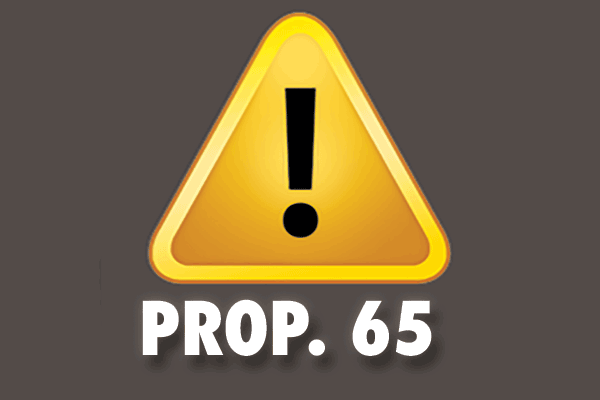 The latest proposed revisions to the state’s Proposition 65 warning regulations are problematic and unworkable, the California Chamber of Commerce and a broad coalition explain in a letter to the agency leading the rule drafting.
The latest proposed revisions to the state’s Proposition 65 warning regulations are problematic and unworkable, the California Chamber of Commerce and a broad coalition explain in a letter to the agency leading the rule drafting.
The revisions proposed by the Office of Environmental Health Hazard Assessment (OEHHA) take several steps backwards by introducing several new and extraordinarily problematic concepts that previous drafts never contemplated, the CalChamber and coalition comment.
The CalChamber-led coalition includes more than 200 organizations that collectively represent nearly every major business sector on which OEHHA’s proposal would have a direct impact.
The coalition has been working with OEHHA over nearly three years now and noted that the state of the current proposal, issued on March 25, 2016, “is particularly concerning given the late stage of this regulatory process.” The deadline for OEHHA to finalize the rule is November 27, 2016.
Undermines Calls for Reform
The coalition points out that the current draft proposal undermines the Governor’s calls for Proposition 65 reform by exacerbating the already-problematic Proposition 65 litigation climate and making compliance so difficult that the only protective measure businesses can take to reduce the inevitable threat of litigation is to “overwarn” about exposures that do not even exist.
Those results will harm businesses, send the wrong message to consumers, and, more generally, will further worsen the reputation of Proposition 65 as a well-intended law that is overly abused by private enforcers who use the law solely for personal financial gain, the coalition writes.
Latest Proposal
OEHHA’s proposed warning regulations will substantially change the way in which businesses provide the warnings required by Proposition 65. The coalition points out that OEHHA’s proposal would:
• Flip the existing statutory burden on businesses by requiring them to affirmatively demonstrate that a warning is required;
• Substantially increase litigation by creating a new breed of “bad warning,” litigation that does not exist today, wherein despite using the precise “safe harbor” warning content provided by OEHHA, businesses would nonetheless be challenged for failing to provide an adequate warning;
• Impose an unworkable, extraordinarily costly and elevated requirement on those providing warnings for environmental exposures;
• Infringe on businesses’ constitutionally protected commercial speech and due process rights;
• Require, for the first time since Proposition 65’s passage in 1986, two warnings for one product; and
• Eliminate the long-accepted method of transmitting warnings via owners’ manuals, which typically contain the most significant safety information for many products.
Additionally, the proposal contains several ambiguities and drafting flaws that require clarification.
CalChamber’s 24-page comment letter elaborates on these issues in great detail and, where applicable, proposes regulatory language to address them.
Because the proposal introduces entirely new concepts on which CalChamber has not yet had an opportunity to comment, the letter requests that OEHHA revise the proposal and circulate another draft for an additional round of public review and comment.
CalChamber will continue to take the lead role on this regulatory proposal moving forward.
Proposition 65 Background
Proposition 65, the Safe Drinking Water and Toxic Enforcement Act of 1986, is the most far-reaching consumer “right to know” law in the nation.
Proposition 65 requires California businesses with 10 or more employees to provide clear and reasonable warning before knowingly and intentionally exposing individuals to chemicals known to cause cancer and/or reproductive toxicity.
Governor Calls for Reform
In May 2013, noting that Proposition 65 has been abused by “unscrupulous lawyers driven by profit rather than public health,” Governor Edmund G. Brown Jr. proposed certain reforms to strengthen and restore the intent of Proposition 65. Specifically, the Governor proposed to:
• end frivolous, “shakedown” lawsuits;
• improve how the public is warned about dangerous chemicals;
• strengthen the scientific basis for warning levels.
These proposed reforms, according to the Governor, were intended to eliminate the practice of bringing “nuisance lawsuits to extract settlements from businesses with little or no benefit to the public or the environment.”
When to Warn
California allows a business to use a chemical without providing warning as long as exposure does not exceed a specified threshold level. The mere presence of a Proposition 65-listed chemical does not trigger the warning requirement; instead, the threshold question is whether the chemicals would expose persons at levels that would require a warning.
Of the more than 800 substances that are on the list of chemicals known to cause cancer, birth defects or other reproductive harm, OEHHA has developed threshold levels for only 300 chemicals to guide businesses in determining whether a warning is necessary. If the chemical is at or below the levels listed, the business has a “safe harbor” from providing a warning.
How to Warn
The current regulations allow businesses to prove they are providing “clear and reasonable” warnings by any means, but also set criteria to establish when the warnings will be deemed “clear and reasonable” for purposes of Proposition 65.
The regulations also lay out warning language and methods for occupational and environmental exposures, alcoholic beverages, and restaurants. Businesses using these so-called “safe harbor” warnings are protected from the threat of litigation and can carry out business with a sense of certainty.
Alternatively, the regulations allow businesses to provide warnings other than those specified, so long as:
• the method employed to transmit the warning is reasonably calculated, considering the alternative methods available under the circumstances, to make the warning message available to the individual prior to exposure; and
• the warning clearly communicates that the chemical in question is known to the state to cause cancer, birth defects or other reproductive harm.
Many businesses have successfully relied on these criteria in providing alternative “clear and reasonable” warnings and have done so without ever being sued.

